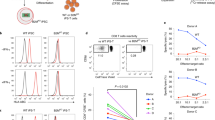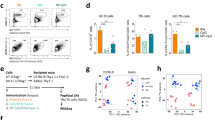Abstract
The polymorphic major histocompatiblity antigens (H–2) have a crucial role in the activation of antigen-specific T lymphocytes. Thus, H–2 antigens are not only recognized by allogeneic lymphocytes leading to generation of cytotoxic T lymphocytes (CTLs), but it has also been demonstrated that in syngeneic systems most T cells are only able to recognize foreign antigens in conjunction with their own MHC (major histocompatibility complex) antigens. This phenomenon, termed H–2 restriction1, may be the key to our understanding of the biological function of MHC antigens. It is not clear whether recognition by T cells of H–2 on a molecular level is confined to particular domains on the H–2 molecule, nor whether the same polymorphic H–2 sites, which are characterized by antibodies, are recognized by allogeneic as well as by H–2-restricted syngeneic CTLs. Previous findings2 indicate the existence of at least two major polymorphic domains on the H–2Kk molecule as defined by antibodies. Here we show the existence of CTLs with specifity for these polymorphic domains, and the preferential recognition of a particular domain by both alloreactive as well as H–2-restricted CTLs.
This is a preview of subscription content, access via your institution
Access options
Subscribe to this journal
Receive 51 print issues and online access
$199.00 per year
only $3.90 per issue
Buy this article
- Purchase on SpringerLink
- Instant access to full article PDF
Prices may be subject to local taxes which are calculated during checkout
Similar content being viewed by others
References
Zinkernagel, R. M. & Doherty, P. C. Nature 248, 701–702 (1974).
Lemke, H. & Hämmerling, G. J. in Monoclonal Antibodies and T Cell Hybridomas (eds Hämmerling, G. J., Hämmerling, U. & Kearney, J. F.) (Elsevier, Amsterdam, in the press).
Lemke, H., Hämmerling, G. J. & Hämmerling, U. Immun. Rev. 47, 175–206 (1979).
Shearer, G. M., Lozner, E. C., Rehn, T. G. & Schmitt-Verhulst, A-M. J. exp. Med. 141, 930–934 (1975).
Cerottini, J. C., Engers, H., Robson, H., MacDonald, H. R. & Brunner, K. T. J. exp. Med. 140, 703–717 (1974).
Fischer-Lindahl, K. & Lemke, H. Eur. J. Immun. 9, 526–536 (1979).
Epstein, S. L., Ozato, K. & Sachs, D. H. J. Immun. 125, 129–135 (1980).
Liberti, P. A., Hackett, C. J. & Askonas, B. A. Eur. J. Immun. 9, 751–757 (1979).
Nabholz, M. et al. Eur. J. Immun. 4, 378–387 (1974).
Author information
Authors and Affiliations
Rights and permissions
About this article
Cite this article
Weyand, C., Hämmerling, G. & Goronzy, J. Recognition of H–2 domains by cytotoxic T lymphocytes. Nature 292, 627–629 (1981). https://doi.org/10.1038/292627a0
Received:
Accepted:
Issue date:
DOI: https://doi.org/10.1038/292627a0
This article is cited by
-
Analysis of structure/function relationships among major histocompatibility complex class I antigens
Immunologic Research (1987)
-
Analysis of the functional epitopes on different HLA-A2 molecules
Immunogenetics (1984)
-
Network regulation among T cells; Conclusions from limiting dilution experiments
Springer Seminars in Immunopathology (1983)
-
Intramolecular organization of class I molecules in relation to function
Survey of Immunologic Research (1983)
-
Structure function relationship of class I MHC molecules
Survey of Immunologic Research (1983)



